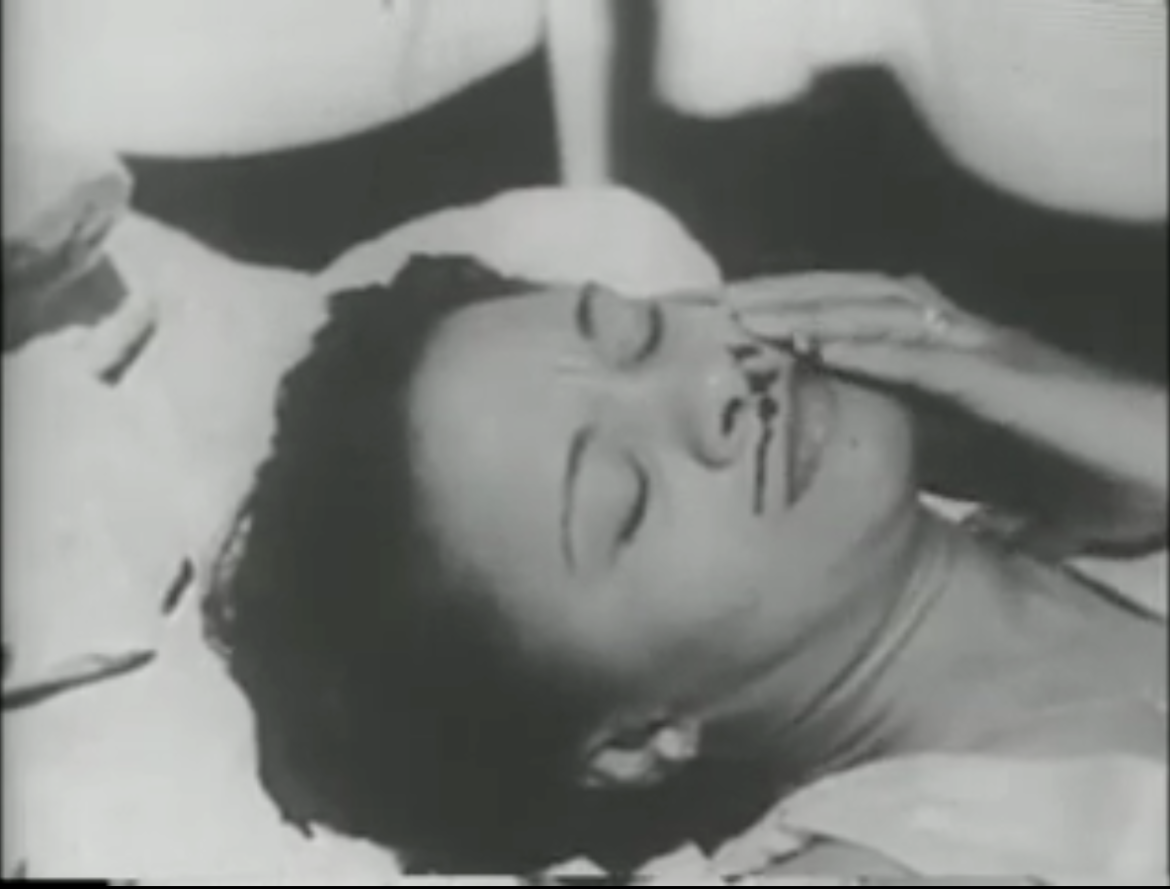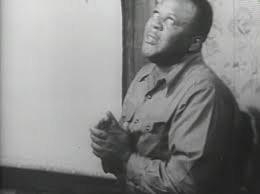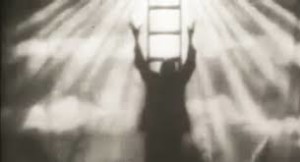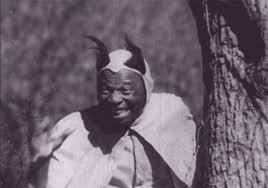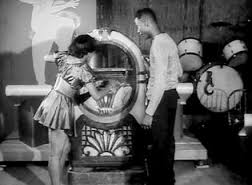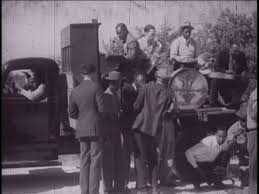Part of an ongoing effort to watch a set of films from non-White, non-U.S., non-male, and/or non-straight filmmakers and depart a little from the Western canon. The intro and full list can be found here.
Famously included as part of the “Tyler, Texas Black Film Collection” – a trove of early race films uncovered in a warehouse in that town, 80 miles outside Dallas, in the 80s – Spencer Williams’ The Blood of Jesus (1941) has had a strange journey to prominence in discussions of the period in which it was filmed.
The film itself was long considered “lost” (though the Library of Congress, at least, had a copy a decade before Tyler). Originally funded, like many race films, by white entrepreneurs looking to capitalize on the segregated Black market denied entrance to mainstream theaters, it was widely viewed as a bit of curiosity, despite being enormously successful in its day.
Williams – a long-time bit player in the silents (including as a tornado-swept passerby in Buster Keaton’s iconic Steamboat Bill, Jr.) and later most famous for playing Andy “Hogg” Brown in the still-controversial “Amos n’ Andy” radio show – is an interesting figure. A prominent director, he tended (then as now) to be overshadowed by his more prolific, celebrated, and independent compatriot Oscar Micheaux. The minstrely-inflected nature of “Amos n’ Andy” didn’t help his legacy, which is still being recuperated from some amount of general embarrassment.
The Blood of Jesus is a full-on passion play, exhibiting many of the trappings one would expect of the kind of theatrical performances that occurred (and still do) throughout many churches around Easter. Its focus is on the rural Southern Black church, its intended audience, and it features numerous Gospel and Blues numbers (usually contrasted against each other in interesting ways).
The film tells the story of Martha Ann Jackson (Cathryn Caviness), a devout woman accidentally shot by her non-religious husband Razz’s falling rifle. (Williams himself plays the wayward husband finding faith through killing his blameless wife.)
As she lays on the bed dying, we follow her into a kind of spiritual limbo. She meets a guardian angel (Rogenia Goldthwaite) and a slick agent of the devil known as Judas Green (Frank H. McClennan), both of whom try to sway her to their sides. Green flatters her with new clothes and tempts her with the worldly ways of nightclubs and that horrible jazz music, but, after briefly becoming embroiled with a pimp in a roadhouse who wants her services (which seem more about robbing patrons than servicing them), she eventually flees to the sanctity of Christ.
Prone before the t-shaped sign at a crossroad, offering Hell one way and Zion the other, she sees instead the Son of God on the Cross. She’s smeared (rather messily on the face) with his blood, and given another chance at life on earth. In the meantime, her husband has found faith and been redeemed through his grief at her bedside. The miracle seals the deal.
There is a lot to unpack here. The film opens on a community Baptism, including that of Martha. Williams gets some laughs out of one would-be Church member who flees the water thinking there’s a snake – “Last year, it was an alligator,” someone mutters. Not everyone is so hyped for the next world. The broad
We meet Razz back at the couple’s home, having just killed a boar – hunting on the Sabbath being the first indication that he’s shirking his duty to the Lord. As it turns out, he wasn’t “hunting” so much as “shooting one of his neighbor’s boars and stealing the body,” so his sin is compounded. The violation of the Sabbath would be bad enough; this is a violation of community norms, too. And then he lies about it to his wife.
After the gun falls to the floor, and Martha with it, we are treated to a depiction of Heavenly ascension that borders on the avant-garde. One might wonder how Williams was able to get the gauzy images and large cast heading skyward on a meager $5,000 budget. It turns out he borrowed it outright – the footage is from a 1911 Italian film, L’Inferno, simply interpolated into the film itself. It’s one of several direct nods Williams makes to earlier productions, as well as evidence of some rather scrappy, if copyright-shrugging, techniques.
At one point in a wide-ranging, fascinating lecture and Q&A about race films, preservation, and Williams, scholar Jacqueline Stewart remarks that his natural filmic descendant today is Tyler Perry. She contrasts this lineage with that of Oscar Micheaux, whose set of cinematic impulses might be found most prominently in the work of someone like Spike Lee.
Stewart quickly complicates the comparisons and argues against any sort of straight line of influence – Lee has claimed never to have seen any race films until after leaving film school, for one thing. But watching The Blood of Jesus, it’s clear what she means more generally. If Micheaux’s focus on intra-racial conflict, interrogation of hierarchies, and appeal to uplift calls to mind Spike’s work, there’s more than a touch of Perry in the morality play that is The Blood of Jesus. (Of course, Spike also went to Kickstarter for his Ganja & Hess reboot, Da Sweet Blood of Jesus, which draws heavily on similar themes, but that’s a story for another day.)
For one thing, as Stewart notes in the video above, The Blood of Jesus is a redemptive tale – but who is redeemed? Sister Martha is the one who goes through the trials and tribulations and temptations, but it is her husband who finds God – she was already on the side of the righteous. Numerous shots link her suffering with the Savior’s, but the narrative implicitly places her as a figure watched and observed by the central male figure.
As in many such tales, the Devil (played to the cheap seats by a a near-comically theatrical James B. Jones) employs a surrogate to prey on her vanity in order to win her over to sin; vanity, of course, being the classic feminine foil. Where Micheaux – in Body and Soul, for instance – controversially attacked the hypocrisies of the Black Church, Williams’ narrative is solidly within the socio-theological framework, one that audiences would surely recognize. As Stewart notes, the question of “authenticity” haunts race films in general, but it’s surely part of the appeal of Williams. Paired with musical standards sung by an actual local choir, cast with local amateurs in the leads and every other part, and reiterating a well-known story, The Blood of Jesus is populist entertainment and intended more for spiritual than social uplift.
The use of music bears further mention. The choir songs and deathbed dirges signal one such use, but there’s also the nightclub jazz on the other, the soundtrack to the “city” that exists as temptation for Martha, steering her away from the Lord.
Stewart and others astutely note that this adds an additional subtext to the film – a juxtaposition of city and country that speaks to anxieties about the Great Migration. Here, there is considerable overlap with Micheaux: just as in God’s Step Children, our protagonist takes in a show, listens to some city blues numbers, sees an acrobatic dancer, and so forth, all definitive aspects of city life in the film’s vernacular. The moralizing is a bit less strong in Micheaux’s deeply weird film – in fact, the two viewers there are a semi-incestuous couple, an upright brother and his half-sister right out of the convent, which is scandalous – but the semiotics are the same. Jazz represents the lure away from grounded rural communities to an unstable, potentially wicked city life.
Williams takes this even further. Not only are the music and clothes of urbanity a lure away from the traditional homes in the community and Church, they are outright diabolical. In a touch that must’ve seemed a bit excessive even in 1941, Williams stages the climax before the cross with a jazz band playing on the back of a truck driven by the devil, who abruptly drives off to Hell after Christ banishes him from the sacred space on which Sister Martha has fallen, face all covered with the Blood of the Lamb.
In its apparent technical amateurism, it’s easy to ridicule The Blood of Jesus as naive or “primitive” – or to exalt it for just that reason, as J. Hoberman of The New York Times would do when he called it “a masterpiece of folk cinema” (though his writing about it now seems more nuanced).
The words “primitive” and “naive” always come off distasteful, a haughty, near-colonialist positioning of viewer over text. In this context, in which I am a white viewer watching a film by and for Black audiences from 75 years ago, this is even more dodgy.
In any case, watching The Blood of Jesus directly after Micheaux’s God’s Step Children, I’m not sure “amateur” is in any way how I would describe Williams’ film – the line-readings are better, the performers are clearly more comfortable, and he’s made the most of his miniscule funding. There is, as it were, a good faith attempt to depict relations between believers and non-believers, and no real condescension or ironic approach to the passion play. Though grounded in the rural, Southern Black Church of the early 20th century, it’s not an unfamiliar narrative to anyone who came of age attending Mass at Easter, but it’s also imbued with the politics and debates of its time and place. The material aspects of its production only deepen the resonance it must’ve had for its audience in 1941.
Again, like all the race movies glimpsed in this series so far, The Blood of Jesus is testimony to the ways in which cinema was being deployed to address anxieties and issues of interest to communities shut out, violently, from the theaters and the mainstream. I struggle to imagine what it must’ve felt like to see anything resembling your experience on screen for the first time.
Viewing these films, I find myself drifting further and further away from notions of “the text itself,” the idea that you must view a film in its four corners and nowhere else. The more you look at old films, the more arbitrary this idea becomes. The question isn’t whether this is a good or bad film, but rather what it means that it existed in the first place, how it came to be preserved, and how it should be viewed today.
Refusal of “extra-textuals” is a mark of bourgeois, and incredibly dull, privilege, and does little to contextualize the cinematic production we encounter. Spencer Williams and Oscar Micheaux continue to have things to say today, and not all of those things are in the films — though the films themselves remain crucial to watch.
Next up: Meshes of the Afternoon, Maya Deren, 1943

